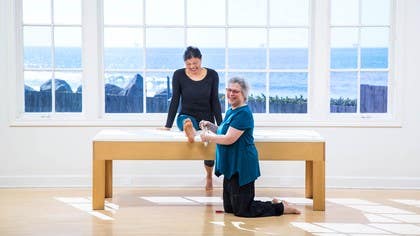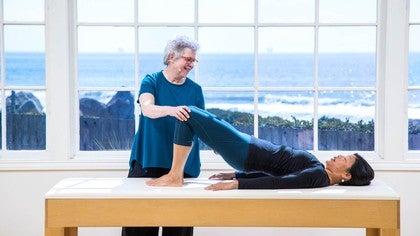Description
About This Video
Transcript
Read Full Transcript
Hi, I'm Leslie Powell from movements afoot. I'm from New York city and I'm so happy to be back at Pilati is anytime we're going to continue with our tutorials on the body and this time we're going to go through the lower body. We're first going to look at bones and bone rhythms and bones are a wonderful way to cue your clients. It can invite a very healthy phrasing and then we're going to go deeper into muscles and what they do from the foot all the way to the hip. And then we're going to end by my teaching a class, a reformer class, using all the concepts about the lower body.
And you'll be amazed how the lower body will also get you into your core differently. We're going to start looking at, um, the structure of the bones and I'm also going to have my colleague Michelle come in and she's going to help look at the bones and how to identify them from this skeleton to a human form. What you first want to look at, here's the pelvis. This is the ilium. If you don't feel confident or touching your client, you can know that it's about here. They could also put their hands on their hips. So go up high and make your hands a little flat and then just go down.
So that will be the top of the ilium in front. If she turns around, there's the top of the ilium from the back. If she turns around, you can know from her pants, like you see the V, that's her femoral fold. That's kind of where the pubis is gonna end. If we look at her sideways here is the acetabulum, which is the hip socket, and you'll feel a bony. That's your greater trow Cantor. So you're going to image that.
That's going to be part of the outside of the hip. Turn around. Now if you look at it, and this is probably a male pelvis, but the femur head goes in, so put your hand at your navel, I'm sorry, put your hand at your hipbone and then point your fingers towards your navel. So that's it there. Yeah, that would be kind of where your hip sockets are. So it's pretty deep within. And you know, different people have different shapes of the shaft. It's something we don't always know when we're working with them, but it's something to observe when they have different rotations that are different from certain clients. Um, this is the femur and what I want you to visually, I'm such a visual learner. If you feel the bone, you can even feel a, if Michelle went down her own leg and you can do it with me, draw your hands down your femur and you can feel that spiral and all these spirals are going to influence how you move your bones in your legs.
Then if we go, here's your patella, also notice this is the condos of the neath. They're not even. So that also is going to influence how the knee, the whole leg moves the tibia. And again, you can see that it, nothing in our body is straight lines. So do you see if as I make a drawing, it has a slight curve. And if you go look at it in different ways, it has different shapes. And so if we were, what you can see, there's the front of her tibia.
Um, and you can feel the, the roundness, some of your clients, um, have what is called tibia torsion. And it's a bonus structure. It's gonna go a little bit more like that. And that's, you just have to work around that. Here's the fibula and that's the outside of the bone. So turn to the side while you're going to, if you can feel the knob Enos up through here.
And then you see the ankle joint that the Mallee OSIS the lateral Mario says, which is the end of the fibula. So what we're gonna go through is what the bone, we call them bone rhythms. Some of you know, some of the material was really written well by Eric Franklin. If you want to go more deeper into it, you can look at Donald Newman, uh, on piles any time. Um, Tom McCook does a wonderful job of bringing the these concepts into his lessons as well as Madelyn black and her book on centering. So there's some really great information about that. So if you put your hands, put your hands at your greater toe cantors and you're gonna play a bend your knees, and then you're going to just straighten your legs. And you, and when I'm talking about these rhythms, we're talking a couple of degrees.
So in a healthy leg, the femur head is rotated outward. And since we can't touch our femur head, we can feel our greater trow candor and you can feel a slight spiral out. And then when we straighten our legs, we turn slightly in. So we femur head turns out, femur head turns in. If you go down to the tibia and the fibula.
And what's so amazing about the body is there's all these beautiful counterbalances that help for movement. And when you find it in your body or your client's body, you're going to invite of different leg alignment and some healthier, um, use of muscles. So I'm going to use my hands, put your hands forward. We're going to imagine that's our fibula tibia. So when we play it does the opposite of the femur. It rotates in and then it rotates out and it rotates in. And then it rotates out, rotates in and out.
And I hope you're doing this, why we're doing this lesson with me, right? So now put your hands, we're going to put those two rhythms together. So femurs, turn out, tibia in, tibia, turns out, femur in, femur out, tibia in, tibia out, femur in. Sometimes it's a lot of words, but okay, so we're going to talk about the talus and the talus is the bone underneath the tibia and it's part of the foot. And what's really wonderful life can get simpler is this rhythm matches your femur rhythm. So that'll make it easier.
So when we are, um, in, uh, our legs are straight, our Taos is, is slightly, uh, turned in. And then when we play a, and it's kind of our talus is on a little diagonal, like a slope. And when we play, the towel is rotates outward and then the talus rotates inward and Talis Rhodes Tates out and Talis rotates in. So the wonderful thing, and then we're going to put all the rhythms together. So remember, the talus and the femur are going to do the same rhythm. So as I play a Talis and femur out tibia in talus and femur in tibia out Talis, femur out, tibia in, tibia in talus and femur in.
So what's great about this is let's say a stand to the outside of your feet. And so do you see in this rhythm her towel, this is turning out too much, this is turning out and her leg is turning now. So sometimes by teaching your clients about that rhythm can start bringing better leg alignment. Or the opposite problem can happen is when you clean a, she's tutored, talus is turned in and it makes her not need. So creating that balance can be very healthy for her.
So we're now going to look on how to bring this into. So we're going to look at the bone rhythms and leg alignment. And so I'm going to have Michelle stand on the outside of her feet. And so now can you see that her talus is turning out and even her fibula is turning out. So you can see that her leg alignment alignment is changing. When she starts rotating the talus in. Go ahead.
You can see that it's starting to make a change and now let's have her plea a and do the opposite rhythm and in her Talis can go in and you can see that it's starting to knock her knees in. So by improving sometimes the rhythms of the bones, it can help the client change their leg alignment. So we're going to look at this on the reformer. So we're going to look at how to apply the bone rhythms to the reformer. And when I'm using my hands on her, I'm being very gentle.
I'm just kinda using my hand to indicated direction. Um, but she, it's really the imagery of the client that's gonna make the most change. Also. It's not, it's not like you're going to have a bicep curl. It's very subtle, but it can be very profound if you look at her right now. Right now she's already, let's have her push out and straighten. So she, her talus is rotating out a little bit too much.
And then we're gonna work on a little, trying to get the balance of the bones a little differently. Bend your knees. Now what I do is I always look at what the learning curve of my client is because it's the tutorial. I'm going to go really fast, but you need to know how fast your client can learn. So Michelle, I want you to put your hands at the greater toe cantors, and I just want you to feel as you push out, it's gonna turn in a couple degrees. So push out, straighten the legs. So your thigh bones turn in. Yes. And then she's gonna turn as she comes in, it's slightly turns out and turn in and then turn out. Now I don't know if you can see it, but the next thing she goes, she does really good. And then she starts hyperextending. So now we're going to get the bone rhythm better at the tibia fibula.
So I'm going to ask her to come a little lower down because I kind of don't want to worry about the mobility of the forefoot. So I'm putting my hands kind of where the fibula is and I'm going to give it a little spin outward. And you're still gonna think about your beautiful femur heads right? So you're going to push out and I'm giving her that little bit. There we go and stop and then come back in.
And my thought is is that I want to get that fibula around and then acts as a break so it doesn't push the femur head backwards. I mean the, the knee backwards. So do you see now I'm going to let her do what she usually does and you see what happens and then bring it back in. So we're going to review that again. If a femur turns in fibula out and then it brings it back. Now we're going to go towards, I'm going to bring her down to the ball, the foot, and we're going to talk about the talus.
So she's going to push out at the towel is, and I'm taking my hands and I'm spinning it. There we go. And then she bring it back in. That's great. And Hal is in and Tallis out. Now we want to get this counter rhythm so as she goes out, talus in fibula, out hold tibia in, talus out. There we go. That was great. There we go. Then we'll go up to the ball, the foot, and when she Relevate talus in, go out, drop the heels down, Talis goes into relevant, go ahead.
And that gets her really better over the big toe. And then bend your knees, come back home. So that's where the bone rhythms, especially for certain clients, you know you have a lot of clients when they go up on their toes, they're going up and the talus is out. Go out, go ahead again and go up on your toes. And they do this so that getting that bone rhythm can improve the whole function of the leg. And then you can come in. Thank you. Great. Okay. We're gonna look at elephant and the bone rhythms. And the one reason I love to do elephant is the client can see their leg alignment. And sometimes when you're doing things as footwork, they don't, they feel different. It doesn't feel normal, but you want to get in their brains how this bone rhythms can improve their leg action. So we're going to do the same thing as she please.
We'll review it again, please. [inaudible] Ben and I'm asking her to push out just a little bit to get the leg active so when she bends her femur, turns out tibia in, Talis out and then when she straightens the femur turns in the tibia, out the talus. And so right now she's having problems because this talus is going out and then one way there's a, this is going out as well, so she's going to plea, yay. And I'm going to get a little more rotation of that talus in and then I'm giving her a little spin and she the more and more talus in and that gets her honor inside lane. There we go, plea a and Hal is in and tibia out. There we go.
And she's going to really have to work on getting that and that way that your client can start getting the mid foot. Now in the rest of the tutorials we're going to go to the foot and then we're going to go up through the knee and the hip and we're going to also look at house. The structures, the muscles can help also the phrasing. So sometimes it's great to go to bone rhythms to teach your clients about working a coordination of the whole leg, and sometimes we need to wake up certain structures to help them find that great alignment, that dynamic alignment of the leg.
Embodied Anatomy: Lower Body
Comments
You need to be a subscriber to post a comment.
Please Log In or Create an Account to start your free trial.












